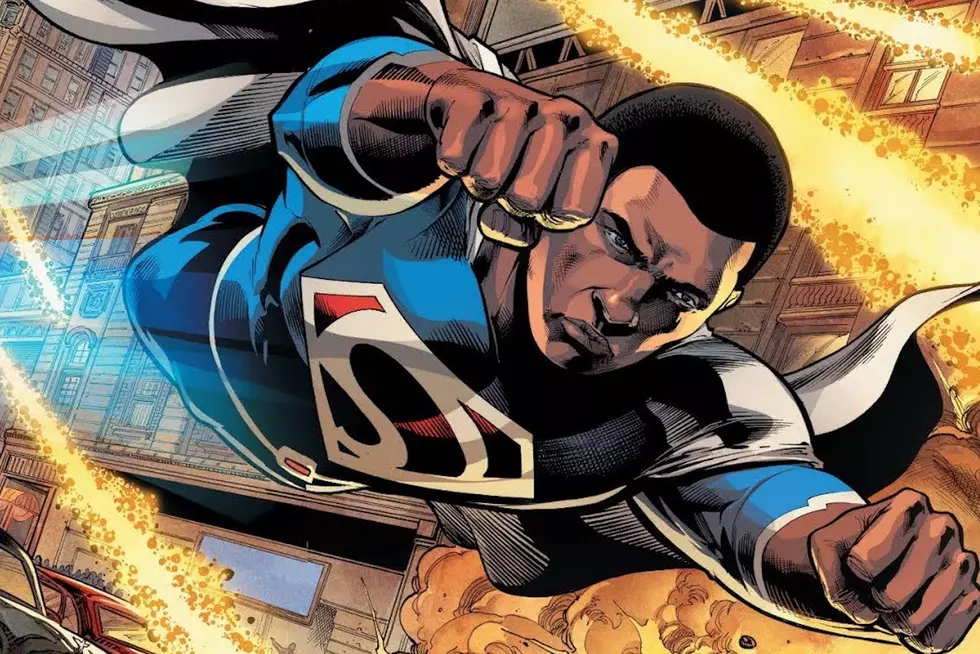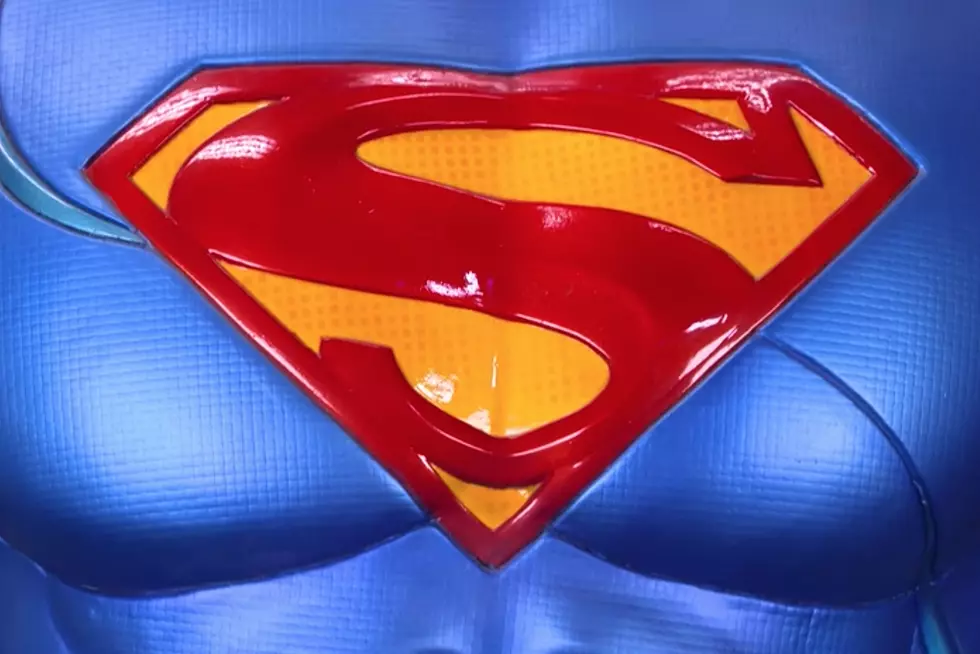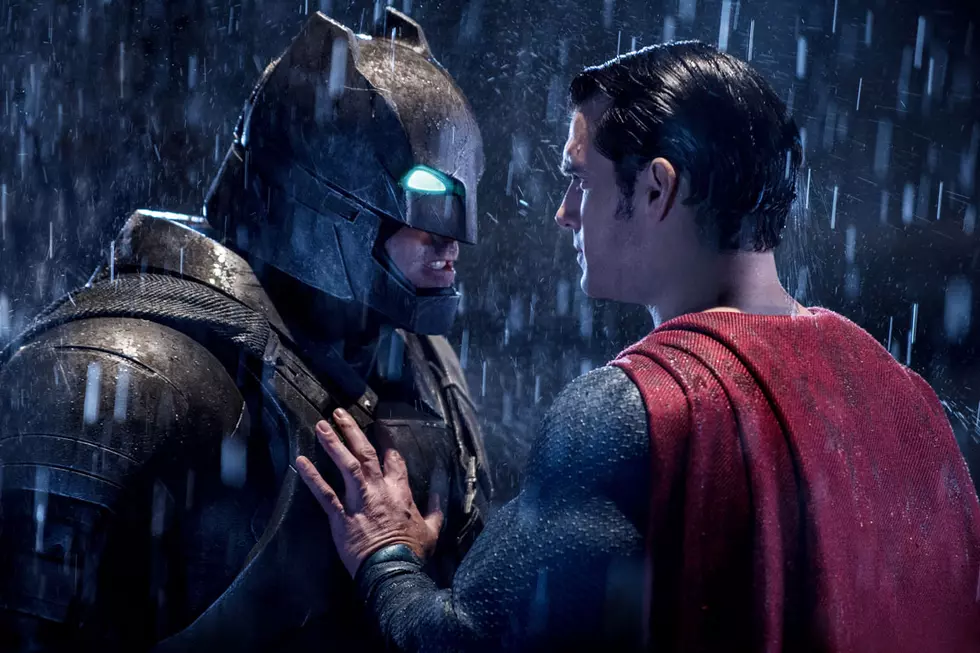
Ask Chris #153: One Superman, Two Superman, Red Superman, Blue Superman
Over a lifetime of reading comics, Senior Writer Chris Sims has developed an inexhaustible arsenal of facts and opinions. That's why, each and every week, we turn to you to put his comics culture knowledge to the test as he responds to your reader questions!
Q: What was the deal with Red/Blue Superman in the 90's? -- @ZdenkoVoloder
A: I don't know when I became the go-to guy for writing about weird, generally-regarded-as-terrible stuff that happened in the '90s, but in this case, it's definitely something I can speak on. See, Superman's weird Electric Blue period was actually last time I bought a comic thinking that it would be "valuable" someday. It, uh... didn't exactly work out.

What do you want? I was fifteen.By 1997, after Knightfall and The Death of Superman (and to a much, much lesser extent, smaller events like Green Arrow's death), DC was well aware that the best way to get media attention was to make huge, very visible changes to their main-line characters and hope they announced it on a slow news day. Since they'd already gone with "killing" Superman, a new costume and a new set of powers after almost sixty years of the standard bullet-, locomotive- and tall-building-oriented abilities was a pretty big shakeup. It worked, too, at least in my case. I hadn't been reading any of the Superman titles at the time -- I believe I was just getting back into the DC Universe through Flash, JLA and Starman after my memorable All-Gen 13-Everything phase at the time -- but I was lured in with the promise that this was going to be a surefire inve$tment that would Change Things For Ever™.
In pro wrestling terms, this is called "being a mark."
To be fair, I wasn't so far gone that I just grabbed it, dropped it into a bag and sealed it in a cool, dry place away from sunlight. I did read it, and while it didn't really do much for me at the time, I actually do respect what the creators were trying to do with it. As much as a lot of those '90s event books didn't actually end up being very good, there are a lot of really solid premises in there. Superman getting a physical enemy that he can go toe-to-toe with after years of dealing with mental threats like Lex Luthor, or Batman having to fight every single one of his enemies at once and being slowly worn down because he just won't stop? Those are good ideas, and at the start, so's The Electric Superman Saga (note: no one calls it that).
At its heart, it's really just a throwback to the "strange transformation" stories of the Silver Age, updated to the modern storytelling style of the '90s -- in fact, it eventually turns into an extended reference to one story in particular, but we'll come back to that. The point is, that's not a bad idea, and considering the success they'd had with reviving other Silver Age elements like Superboy, Supergirl, the Bottle City of Kandor and, you know, "The Death of Superman," it makes sense that they'd want to try.
The problem is that it's a "strange transformation" story that goes on for a year, with an installment every week. And also that it doesn't make a whole lot of sense.
It doesn't help that I only have half the story -- this thing came out weekly in four different titles and I've only got the Superman and Action Comics issues for it all -- but as near as I can figure, we start out with a pretty interesting idea: Superman starts to break down on the cellular level, presumably because Kryptonians aren't actually supposed to be powered by yellow sunlight. Superman's body, having absorbed and expended a ton of energy that he was never biologically supposed to be processing (and having been dropped back into the Kryptonian Gestation Matrix as an adult so that he could be repaired after a giant bone monster in green bike shorts punched him to death) was starting to convert to energy that would just dissipate.
This, of course, led to Superman accidentally blowing up toasters.

As someone who likes just a little bit of weird pseudoscience in his superheroics, that's a really compelling idea to me. It plays off the post-Byrne idea that Superman's powers are all derived from a sort of electropsychic field that surrounds his body and, way more importantly, it provides one of those classic Superman moral problems. It's a deadly consequence of actually using his powers that he could've probably avoided if he'd stopped, but for him, the choice between saving his own life or helping others isn't really a choice at all.
Those are all good ideas, but when it came time to translate them to the page, things fall a little flat. The actual route from toaster explosions to new costume takes four issues, and when it actually happens, it's just Emil Hamilton turning Kelex (we all remember him, right? Superman's Kryptonian Robot Pal? From the '90s?) into some circuitry and then sewing it into a bolt of super-cloth that Lex Luthor sends over because he had some laying around and wants to stop Superman from dying for some reason.
Seriously. Super-cloth. From Lex Luthor. Who had it on hand for just such an occasion.

I will admit that as goofy as that scene is, Super-Scientist Emil Hamilton's "LexCorp is BAD NEWS!" tickles me to no end.
As you might expect, it works (and Hamilton was nice enough to sew in some electricity themed trim and leave a big blank pentagon on the chest where he could write "Hope" the letter S), he visits his mom and dad in a pretty sweet moment, and by the end of the month, we finally have Superman with a new costume and new powers:

The thing is, those new powers aren't really defined very well by the rest of the issue. He's just sort of vaguely "made of energy." Don't get me wrong, there are a few interesting aspects of itL He's now incorporeal so that bullets pass through him rather than bouncing off, which means that he now has a harder time performing his primary function of stepping between innocent bystanders and the things that threaten him, and when he's not Superman, Clark Kent is an ordinary human being without any powers. That presents a nice set of interesting problems, but it's weirdly inconsistent. Electric Superman is incorporeal when people are shooting at him, but not when he needs to punch people. He's a regular human as Clark Kent, but he doesn't get into a lot of situations where this is something he can't solve by just turning into Superman and moving at the speed of light.
And then there are the secondary powers, where he can read CDs because of electricity, or become one with the Internet.

I maintain that this is actually an amazing idea that just came out before its time. Who wouldn't want to see Superman get sucked into today's Internet and spend an issue battling against renegade cat pictures and racist Facebook statuses? Ten years later, when comic book creators had a better understanding than just "the files are inside the computer?", that woulda' been gold. Incidentally, I am available to write Superman vs. The Internet, and I work cheap.
Anyway, things weren't really defined that well, and while that can be forgiven because we don't really need to know how things work, the bigger sin is that he didn't really do much with the new powers. It was all just the same old stuff with a couple of added "oh no, bullets go through me now!" lines added in for seasoning. Even in JLA, which was hitting on some great, creative scenes, he wasn't doing anything that that "regular" Superman couldn't, and the story actually suffers for it because it just feels like someone's drawing him wrong. Superman wrestling a renegade angel is a great visual, but when it's a weird, off-model Superman, it loses something.
The closest he ever really came to putting his powers to work was by using them to create a gigantic magnetic field to repel the moon when it was about to crash into the Earth...

...but even that's just a different method to get something we've seen before. Superman moving planets around is impressive in theory, but we've seen it enough that it's a cliché that's been goofed on in books like Supergirl and Majestic, and even on TV. I guess you could argue that "same stuff in a new way" was kind of the point, but why not just do new stuff? Solve the problem in a different way rather than just getting to the same solution by a different route.
Suffice to say, Electric Superman was a little disappointing. But here's where it gets weird.
As the story continued, the creators decided to double down (har har) on the idea of a Silver Age transformation throwback by reintroducing an old concept: Superman Red and Superman Blue.

You probably already know this bit, but much like The Death of Superman, this is all a reference to an "Imaginary Story" from the Silver Age. Specifically, it's 1963's "Amazing Story of Superman-Red and Superman-Blue" from Superman #162, where Superman duplicates himself and then sets about solving all the problems, up to and including which of their two girlfriends they should marry. Red gets Lois, Blue gets Lana, Jimmy get shackled with the atrocious hellbeast that is Lucy Lane, and Lori Lemaris remains underwater where no one can see her tears. It's a good one. The modern version, though...
Again, this happens in a special that I don't have, but the gist of it is that Cyborg Superman -- you know, the half-robot Astronaut that thought it was Superman for a little while and then fought Green Lantern fifteen years later? -- invents a machine that can split someone into two extremes of their personalities. I don't know how he did this, but let's be real here: He's a half-robot astronaut. Dude knows a lot of things.
Either way, it worked, and Superman was split into the hot-headed Superman Red (who we know is hot-headed because he says "dude" and starts droppin' the G of the end of his words) and the more cautious, ultra-nerdy Superman Blue. They don't get along.

For the record, if you're reading a comic that addresses you as "fanboy," it's best to just put it down and walk away. Sorry, Lobo fans (I'm not really sorry).
The Supersman end up getting into a fight with a bunch of big monsters that I'm sure we all remember called the Millennium Giants, and then he gets his regular powers back. This is never really explained. It just happens, and Superman refers to it as a reward, but the real reason is a little closer to "It's Superman's 60th anniversary and we can get Alex Ross to paint a cover."
That was basically the end of that, although the actual containment suit cropped up a few more times, first on a minor character called Strange Visitor, and then more recently courtesy of Chris Roberson and Eddy Barrows in Superman #711, where it was passed along to Livewire, a reformed villain originally seen on Superman: The Animated Series.

Even though it's just a swimsuit and crazy dominatrix boots, I like the simplicity of Livewire's original look a lot, but that's a nice way to get some usage out of the Containment Suit and tie her in visually to the Superman family.
So yeah: Electric Superman. Some very good ideas and a motivation that I really like -- bringing back "classic" elements of Superman in a more modern setting -- but done in a way that all but shines a spotlight on the problems of modern storytelling. It took four 22-page comics a month for an entire year before it was all said and done, didn't really justify itself, and relied more on nostalgia and people who were in on the joke to sell the idea rather than using those elements in a new and interesting way.
On the other hand, it's what finally killed the Super-Mullet, so I guess that one could go either way.
If you've got a question you'd like to see Chris tackle in a future column, just send it to @theisb on Twitter with the hashtag #AskChris, or send an email to chris@comicsalliance.com with [Ask Chris] in the subject line!
More From ComicsAlliance









